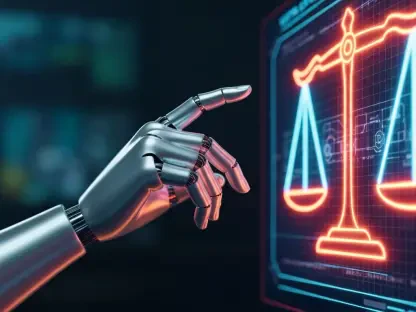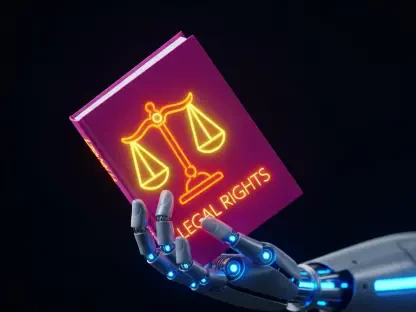The Evolving Landscape of the Legal Profession
The legal industry stands at a pivotal moment, with technology reshaping every facet of practice at an unprecedented pace, challenging traditional methods and demanding swift adaptation from professionals across the board. Once reliant on manual processes, the sector now integrates advanced tools that streamline operations, driven by the urgent need to meet modern demands. Artificial intelligence has emerged as a cornerstone of this transformation, fundamentally altering how legal tasks are approached and executed.
AI’s integration into legal practice is evident in areas such as legal research, document drafting, and e-discovery, where it accelerates processes that once took hours or days. Major platforms like Bloomberg Law, Lexis, and Westlaw have incorporated AI capabilities, positioning themselves as key players in this shift by offering tools that enhance efficiency and accuracy. These developers, alongside other tech innovators, are redefining the market, pushing law firms to adopt such solutions to remain relevant in a rapidly changing environment.
The significance of this technological wave cannot be overstated, as client expectations for faster, more cost-effective services continue to rise. Law firms face intense competitive pressure to leverage AI, not just to improve outcomes but to meet the growing demand for innovation. This shift underscores a broader trend: technology is no longer optional but a critical component of delivering value in the legal field.
AI Adoption in Legal Practice: Trends and Insights
Emerging Technologies and Market Drivers
AI adoption in the legal sector is propelled by powerful forces, including client insistence on quicker turnarounds and the strategic advantage gained through advanced tools. Law firms are increasingly turning to AI to handle repetitive tasks like contract analysis, allowing attorneys to focus on higher-level strategic work. This trend reflects a broader push toward efficiency, where staying ahead means embracing cutting-edge solutions.
While AI often surpasses human attorneys in speed and data processing for specific functions, it carries inherent risks, such as errors or fabricated outputs known as hallucinations. These flaws can undermine trust and lead to significant setbacks if not managed properly. Despite such challenges, the potential for AI to revolutionize workflows remains undeniable, offering a clear path to reduced costs and improved service delivery.
Law firms that harness AI effectively can distinguish themselves in a crowded market, meeting client needs with unprecedented agility. The drive for innovation is not merely a trend but a fundamental shift in how legal services are perceived and provided. As adoption grows, the ability to balance technological benefits with caution against pitfalls becomes a defining factor for success.
Performance Metrics and Future Outlook
Current data reveals both the promise and the peril of AI in legal practice, with over 280 documented errors in court filings attributed to AI misuse in recent years. Such statistics highlight the pressing need for better oversight and training to mitigate risks that could damage professional credibility. These incidents serve as a stark reminder that technology, while powerful, is far from flawless.
Looking ahead, AI’s role in the legal sector is poised to expand significantly, with projections indicating a deeper reliance on these tools in the coming years, particularly from now through 2027. Advancements in accuracy and functionality are expected to address some of the current shortcomings, making AI an even more integral part of practice. This trajectory suggests that adaptation is not just beneficial but essential for future relevance.
Lawyers must embrace these tools as a non-negotiable element of their profession, recognizing that resistance to change could hinder career progression. The evolving landscape demands a mindset shift, where technological proficiency becomes as fundamental as traditional legal skills. Firms and individuals alike will need to prioritize learning to navigate this new terrain effectively.
Challenges in Legal Education: The AI Training Gap
Law schools face a critical challenge in preparing students for a profession increasingly defined by technology, as most curricula lack dedicated AI training. This gap leaves graduates ill-equipped to handle the tools that are becoming standard in practice, creating a disconnect between education and real-world demands. The oversight risks producing professionals unprepared for the complexities of modern legal work.
Without proper instruction, new lawyers are vulnerable to ethical missteps, potential malpractice, and compromised client service stemming from AI misuse. The absence of structured guidance on navigating these systems can lead to costly errors, damaging both reputations and outcomes. This unpreparedness is a systemic issue that threatens the integrity of the profession if not addressed promptly.
Solutions to this problem include embedding AI education within core courses and establishing partnerships with technology providers for hands-on experience. However, resistance persists within academia, with some educators questioning the reliability of AI tools for student use. Counterarguments stress the urgency of preparation, asserting that delaying training ignores the reality of widespread industry adoption and the immediate need for competence.
Ethical and Regulatory Implications of AI in Law
The use of AI in legal practice operates within a regulatory framework that emphasizes technological competence, as outlined by the American Bar Association’s Model Rule 1.1. This guideline mandates that attorneys stay informed about relevant advancements, ensuring they can leverage benefits while mitigating risks. Compliance with such standards is not optional but a cornerstone of professional responsibility.
High-profile cases of AI errors, including fabricated citations in court documents, have resulted in sanctions and fines, underscoring the consequences of inadequate oversight. These incidents highlight the necessity for strict adherence to ethical practices when using technology in legal settings. They also serve as cautionary tales for practitioners who might underestimate the importance of validation.
Ethical training plays a vital role in addressing these risks, teaching lawyers to recognize AI limitations and verify outputs diligently. Additionally, disclaimers from legal tech platforms about potential inaccuracies place further responsibility on users to exercise caution. Balancing innovation with accountability remains a critical challenge, shaping how technology is integrated into professional conduct.
The Future of Legal Education in an AI-Driven World
Legal education must evolve to reflect the realities of an AI-driven industry, advocating for a curriculum that blends traditional skills with technological proficiency. This approach ensures that graduates are not only versed in legal theory but also capable of navigating the tools shaping modern practice. A forward-thinking mindset is essential to meet emerging demands.
Innovative educational models are beginning to surface, incorporating hands-on AI training and courses that explore technical foundations, such as large language models, alongside ethical considerations. These programs aim to produce well-rounded professionals who can critically assess technology while upholding legal standards. Such initiatives mark a significant step toward aligning academia with industry needs.
Potential disruptors, including rapid advancements in AI capabilities and shifting expectations for tech-savvy lawyers, will continue to influence educational priorities. Global trends of widespread AI adoption further amplify the demand for reformed training programs that prepare students for an interconnected, technology-centric legal landscape. Adapting to these changes is crucial for maintaining relevance in a dynamic field.
Conclusion: Bridging the Gap for the Next Generation of Lawyers
Reflecting on the insights gathered, it becomes clear that AI has already transformed legal practice, yet law schools have lagged behind in equipping students for this shift. The critical findings point to a glaring disconnect between industry demands and academic preparation, posing risks of ethical violations and professional shortcomings. This gap underscores a pressing need for immediate action to align education with technological realities.
Moving forward, law schools are urged to adopt a dual-focus curriculum that integrates AI proficiency with traditional legal training, ensuring graduates can thrive in a competitive market. Overcoming resistance to change within academia is identified as a necessary step, alongside forging partnerships with tech providers for practical exposure. These measures promise to strengthen the foundation for future lawyers, preparing them to navigate both opportunities and challenges.
Beyond immediate reforms, the broader potential for growth in legal education is evident, as aligning with industry needs offers a pathway to innovation and relevance. Stakeholders are encouraged to prioritize long-term strategies, such as continuous curriculum updates and faculty training, to sustain momentum. Embracing this evolution is seen as the key to empowering the next generation of lawyers in a tech-driven era.









